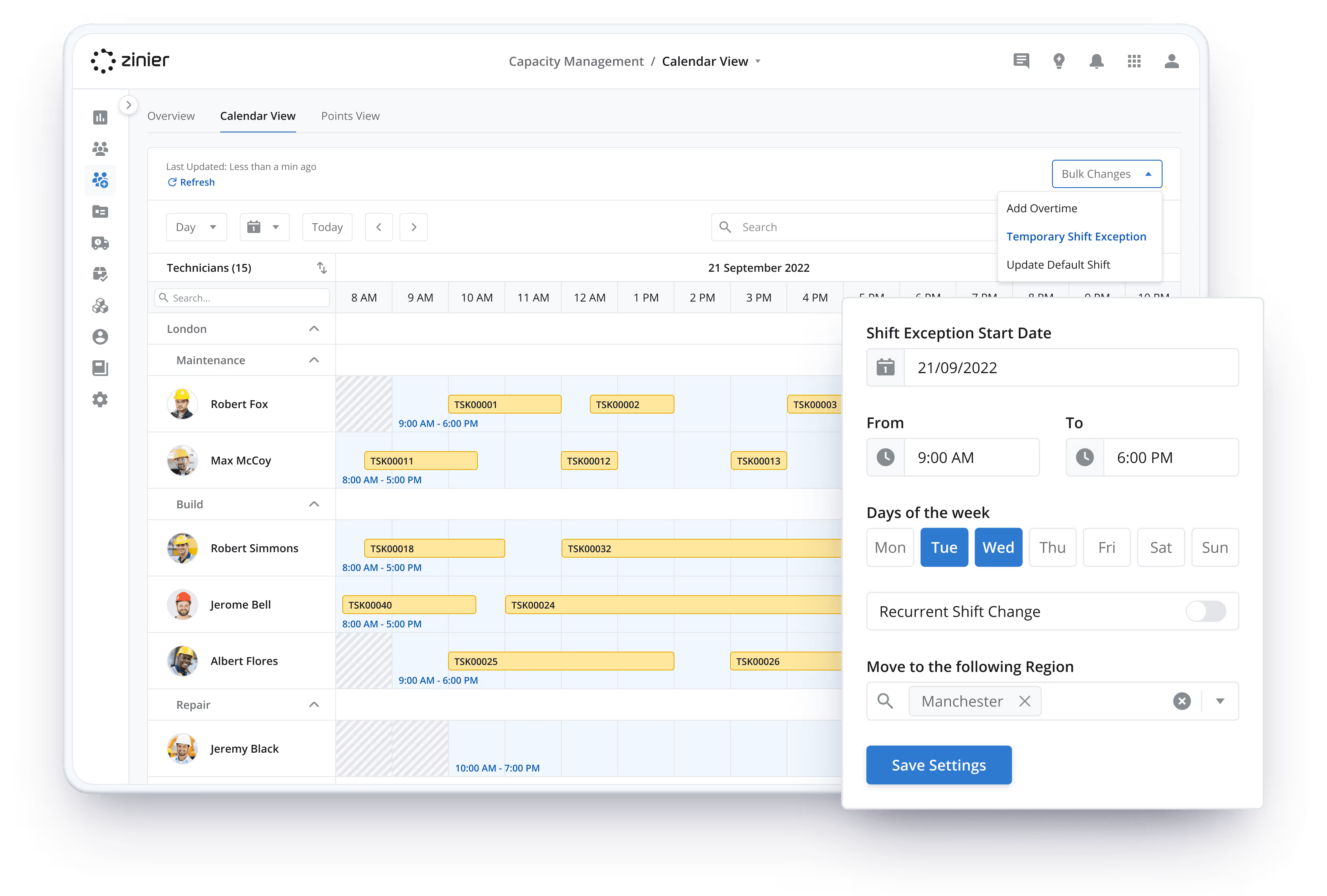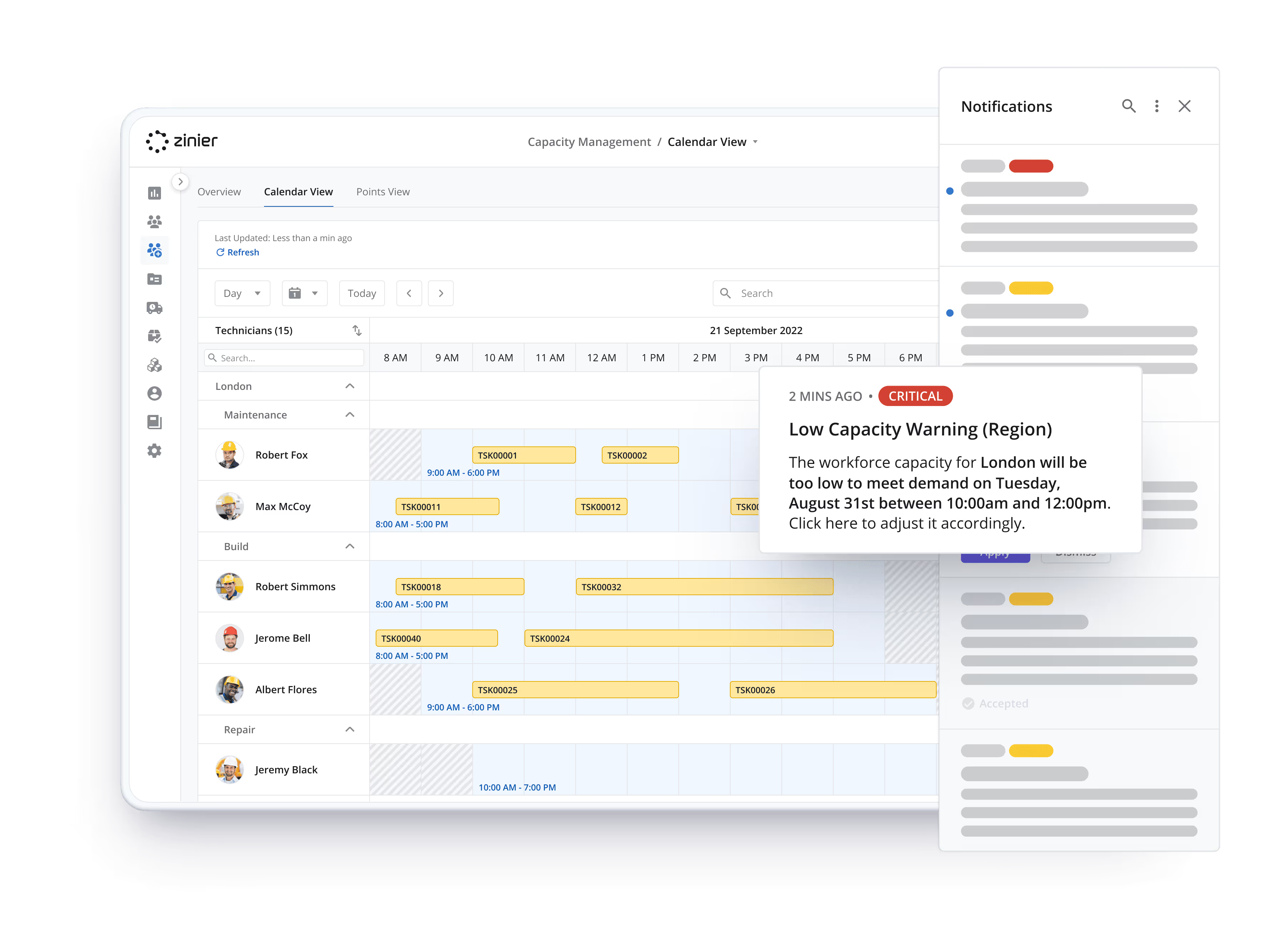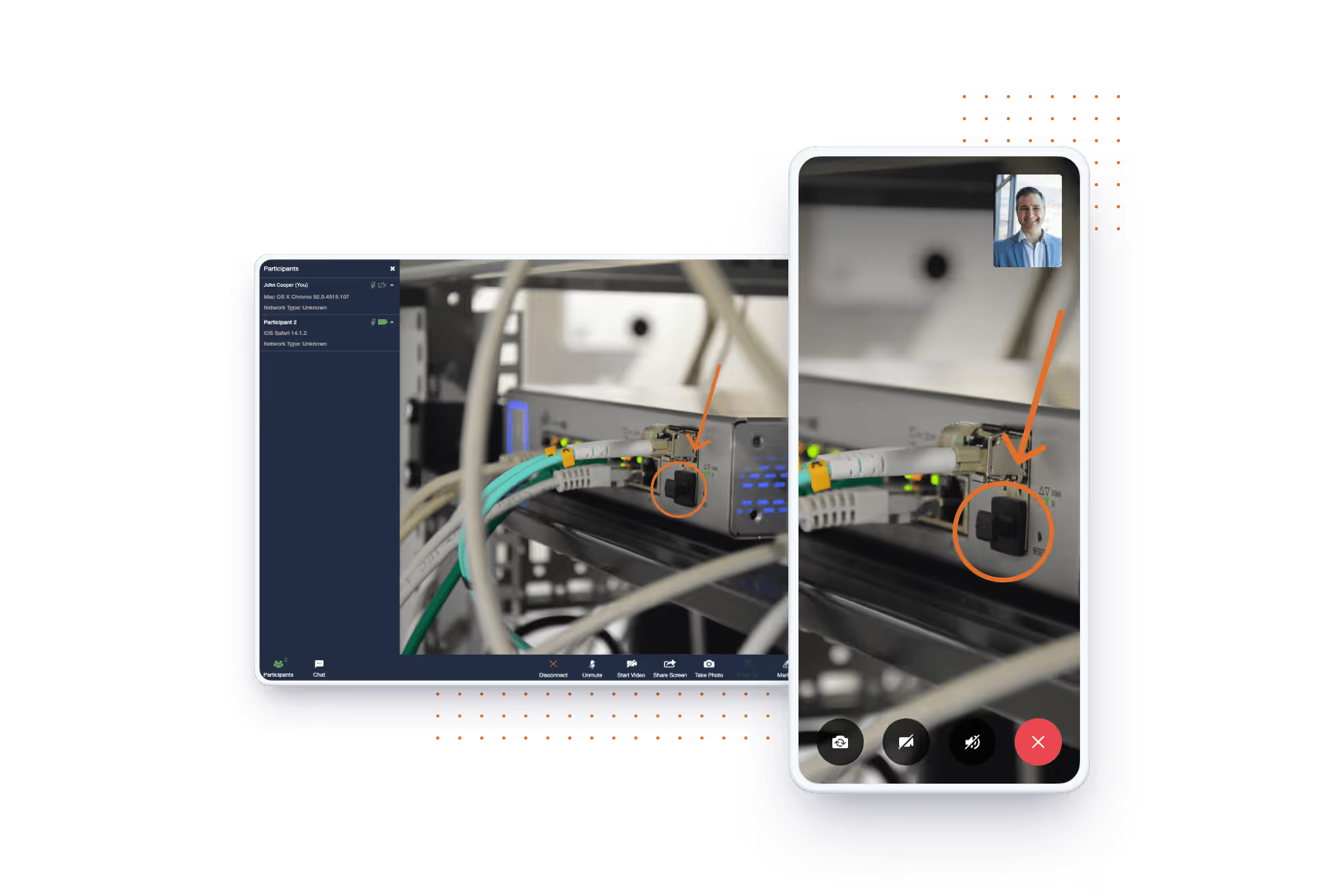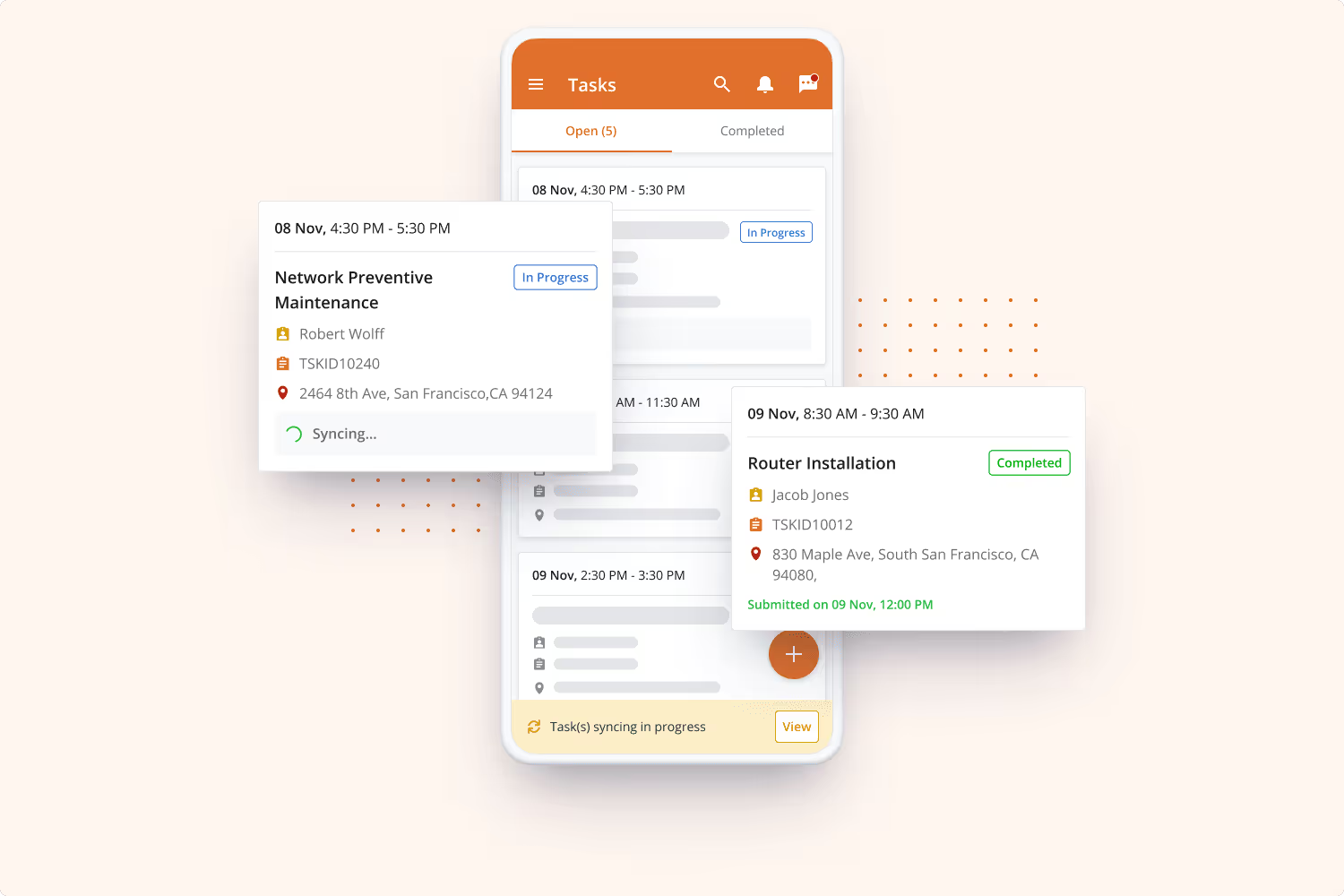The Capacity Management Advantage
Remember the story of Goldilocks – always looking for that “just right” balance between too much and too little? It’s a familiar feeling for many people in field service management who need to plan for capacity. If you have too many field workers, you wind up paying people just to wait around for the next job. But if you didn’t catch that a surge in demand was coming your way, you won’t have enough workers available, and you’ll wind up taking a hit on SLAs or customer satisfaction.
Here’s a look at some of the common challenges associated with managing capacity and a preview of how Zinier’s new Capacity Management product solves these problems.
Too hot? Too cold? Too late!
Optimizing for capacity is a balancing act, and when you get into the weeds, a number of specific challenges present themselves:
Resource training takes time
Field service resources take time to hire and train. If demand shifts unexpectedly, a field service team may not have the skilled resources to deliver quality service in one area, or you might be over-supplied with resources in another.
Predicting resource demand is critical
Because resource hiring and training takes time, field service organizations clearly benefit from an effective way to predict capacity so they can better plan and optimize their future resourcing needs.
Capacity/demand visibility
Many field service organizations struggle to answer two important questions:
- What is the current capacity of my team? In other words, how many jobs can my current roster of technicians fulfill in each region?
- What is my current demand? How many jobs do I need to fulfill in each region?
These questions may seem simple. But the reality is that many field service organizations find it challenging to answer them with confidence.
Proper planning is critical but only half the battle. To stay agile and adapt to day-to-day changes, an operator must first be able to answer these questions and see accurate real-time resource allocation and demand.
Manual Capacity Reallocation
Even with a clear picture of current demand and capacity, what happens when you face a sudden surge in demand or a technician in your region falls sick? When the unexpected happens, operators need to be able to shift resources to meet the demand and keep their end-customers happy. That’s a tall order when current processes are manual and time-consuming.
Finding the Perfect Balance
Our Capacity Management product can help free you from the Goldilocks-style games of trial and error that you may have simply grown accustomed to. Capacity Management incorporates three distinct solutions, designed to tackle all of these challenges: Capacity Planning, Capacity Utilization, and Capacity Automation.
Capacity Planning
Capacity Planning provides a looking-glass into the future. It helps you see how your workforce is shaping up over the next few weeks and configure boundaries on your overall capacity.

Define capacity allocation rules
Easily created rules enable you to define availability and allocate capacity to your workforce.
Shifts, leave, and overtime
You can also define shifts to set each worker’s work schedule (as well as leave and overtime schedules) to calculate the real capacity of your workforce at any given time.
Real-time capacity/demand visibility
With capacity-focused dashboards, you’ll gain real-time visibility into actual demand and capacity.
Capacity Utilization
As perfectly as we try to plan for the future, unexpected issues inevitably crop up – often at the last minute. It might be a job running over or a technician falling sick. When the unexpected happens, Capacity Utilization provides guidance on tap whenever you need to make real-time decisions about how to adapt and manage your workforce.

Capacity analysis
Analytical tools provide the insights you need to make capacity decisions. You can easily change your view into capacity across days, weeks, or a months to make informed decisions on workforce distribution and get real-time visibility into capacity and demand.
Flexibility to view by points or time
In addition to switching time frames, you can also show capacity based on the calculation you’re accustomed to, whether that’s points, hours or minutes.
Capacity reallocation with shift exceptions
Adapting to unexpected changes is no problem when you can create temporary shifts for technicians. Options include reassigning technicians to alternate regions or redefining their working hours to meet the new demand.
Make bulk changes
Need to edit details for multiple technicians? You can perform bulk changes to add overtime, temporary shifts, or update the default shifts for technicians.
Customer appointment booking rules
Something that’s often overlooked is that capacity information isn’t just important for you and your workforce – it’s also important to your customers! Our capacity module feeds real time information via APIs to show your customers what appointment windows are available.
Capacity Automation
Capacity Automation lets you streamline these functions by providing alerts about out-of-line situations and recommendations to help you address capacity issues ASAP – sometimes before they even happen.

Automated capacity reallocation
You can leverage recommendations for reallocating resources between capacity groups to minimize tedious manual work.
Automated shift/overtime exceptions
Similarly, you can leverage recommendations for allocating overtime or adjusting shift times so you don’t have to do so manually.
Capacity alerts
Prompts notify you when capacity is running low and at risk of not meeting demand, so you can take action before SLAs are jeopardized.
Automated capacity plan generation
Automate your capacity plan based on configured inputs like distribution, number of jobs, average driving time, and so forth.
Capacity Forecasting (Coming Soon)
Capacity/Demand Forecasting helps planners calculate future workforce needs and optimize their team distributions. Users can run different what-if scenarios using either historical data or manual inputs.

Predict demand based on historical data
By training custom AI models, you’ll improve your ability to predict demand based on your own historical data.
Run “what if” scenarios to forecast
Test different what-if scenarios to give you a sense for how demand could change in various scenarios.
Calculate necessary workforce capacity
Stay ahead of the curve and calculate future workforce capacity based on predicted demand.
Want to see the Zinier platform in action? Schedule a demo today!






.svg)

.svg)

.svg)





































%2520-Hero.avif)
%2520(1300%2520%25C3%2597%2520860%2520px)%2520(5).avif)
%2520(1300%2520%25C3%2597%2520860%2520px)%2520(7).avif)

%2520-%2520Hero.avif)
%2520-%2520Thumbnail.avif)
%2520-%2520Thumbnail.avif)





%2520-%2520Thumbnail.avif)
%2520-%2520Hero.avif)